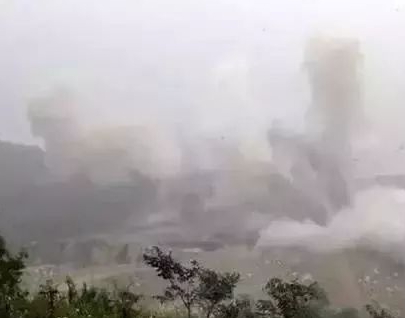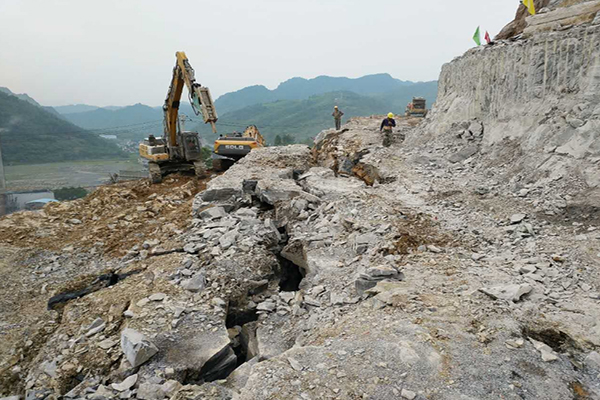Analysis and comparison of blasting technology in mining engineering: CO2 rock blasting VS explosive blasting
New technology: O2 rock demolition system
Link:
In mining, the ore must first be stripped from the rock mass and the surrounding rock of the ore body roof through mining blasting, and then blasted into a certain blast pile according to the project requirements, and broken into a certain size of blocks to create conditions for subsequent shoveling and transportation. Mining blasting technology has developed rapidly with the construction of mining projects. Different blasting methods have a great impact on mining costs. In the whole process of mining, the cost of perforation blasting accounts for about 20% of the total cost. Selecting a specific blasting method according to the rock structure of the mine can not only improve the blasting effect, but also save mining costs.
Mining is dangerous, so blasting can only be carried out after a strict approval procedure. Some mining areas are close to buildings. Therefore, when blasting, not only large pieces and foundation phenomena should be considered, but also vibration, flying stones and dust phenomena should be avoided as much as possible to avoid the impact on surrounding buildings and residents. In the traditional mining blasting process, the most commonly used method is explosive blasting. Explosive blasting is powerful and highly destructive to rocks. It can effectively meet the blasting requirements, but there are great safety hazards. Therefore, the approval procedure for explosives is relatively complicated. In order to solve this problem, a relatively new form of blasting has emerged in society, namely CO2 rock blasting.
The CO2 fracturing device uses the physical principle that liquid CO2 absorbs heat and expands, and the pressure rises rapidly. It consists of a steel pipe filled with liquid CO2, an activator, an energy release component, an inflating component, an ignition circuit connection component, and other connection auxiliary components. The liquid CO2 is instantly gasified by heating with an activator, releasing high-pressure gas energy to crack target materials such as rocks, coal seams, and concrete. It solves the shortcomings of the previous mining and pre-splitting with explosives, such as high destructiveness, high danger, and ore body crushing, and provides a reliable guarantee for safe mining and pre-splitting in mines. Comparison of advantages and disadvantages of explosive blasting and CO2 rock blasting
Advantages of explosive blasting: 1. Strong power and significant crushing effect; 2. Relatively low blasting cost; 3. Simple blasting process and high blasting efficiency Disadvantages: 1. High risk factor and difficult approval; 2. High destructiveness, easy to affect surrounding buildings and residents; 3. Strong crushing, resulting in reduced utilization of stone; 4. Serious noise and dust pollution, not environmentally friendly.
Advantages of CO2 rock blasting: 1. No strict approval is required, easy to use; 2. Low noise, reducing the impact on surrounding residents; 3. Environmental protection, reducing environmental pollution; 4. Reduce the risk factor and high safety; 5. Avoid ore body crushing and improve stone utilization; 6. Some devices can be reused.
Disadvantages: 1. The steps are too complicated and inefficient; 2. It is not suitable for deep foundation pits or working surfaces with poor volleying; 3. It is impossible to achieve multi-row blasting and the output is low; 4. The activator used is a disposable item with high cost; 5. The blasting tube filling process and on-site construction are relatively complicated, and the quality requirements for the blast-hole are relatively high.
Although CO2 rock blasting can make up for the problem of difficult approval for explosive blasting, it is still difficult to replace the position of traditional explosive blasting in a short period of time because the blasting power is weaker than that of explosives and the cost is higher. The following mainly analyzes how to optimize the parameters of traditional explosive blasting and reduce the cost of blasting. Optimize explosive blasting parameters to reduce blasting costs
The complete process of open-pit mining consists of drilling, blasting, shoveling, transportation and crushing, among which the cost of drilling and blasting accounts for about 20% of the total cost of the entire mining procedure. Therefore, it is necessary to choose a suitable blasting scheme to effectively reduce the mining cost of the mine. In order to reduce the cost of blasting, it is usually necessary to go through the following links to optimize the blasting parameters.

1. Geological survey
The level of detail of the geological survey has a significant impact on the blasting effect. Before blasting, a professional team can be asked to conduct photo grammetry of the rock mass on the slope of the mine step to obtain digital images of the macroscopic structure of the rock mass, and use certain technologies to analyze the hardness and integrity of the rock.
2. Calculate blasting cost
Based on the current blasting parameters of the mine, the blasting effect is quantitatively evaluated by statistically analyzing the blasting large block rate, and the relationship between the main blasting parameters and the large block rate is calculated, and then the blasting cost is analyzed. The large block rate will not only affect the blasting cost, but also the shovel cost, transportation cost and secondary crushing cost. The second is to optimize the blasting parameters and find the best blasting plan.
3. Optimize blasting parameters
Open-pit mine blasting generally requires concentrated blasting piles after blasting, uniform block size, and control of large block rate. Combined with these requirements, and considering reducing blasting costs, it is generally necessary to start with parameters such as step height, filling height, charge length, charge structure and detonation method, delay time, and detonation network for optimization.
(1) Step height
The step height is mainly calculated by the diameter of the blast hole. At the same time, for mines with a certain mining depth, when the step height is small, the unit consumption of explosives can be reduced, but the number of steps, the total length of the perforation and the consumption of detonating equipment will increase. However, in general, the cost of perforation blasting will be reduced. Therefore, the step height of the mine can be reduced to a reasonable height as much as possible according to the actual situation and annual output of the mine.
(2) Filling length and charging length
During the blasting process of the mine, when joints and fissures are developed, increasing the spacing between blast holes can achieve better blasting effects. In order to make full use of the perforation length, each blast hole, in addition to meeting the filling length requirements, the remaining length is used for charging.
(3) Charging structure and detonation method
In order to enhance the blasting effect and meet the blasting block size requirements, the charging structure can adopt a columnar continuous charging structure, and the detonation method adopts detonating cord detonator detonation. For explosives without detonator sensitivity, detonating bombs can be used for detonation. Insert the detonator into the detonating bomb and ensure that the energy-gathering hole of the detonator faces upward to detonate the explosive.
(4) Delay time
There is a general empirical formula for calculating the delay time, namely △t=kB, where B is the resistance line, k is the delay coefficient, and the value range of k is 3-8, with a small value for hard rock and a large value for soft rock. The specific value should be determined based on the survey of the mine. Under normal circumstances, the delay time is 65ms.
(5) Detonation network
Micro-difference blasting can effectively control blasting shock waves, vibrations, noise and flying stones. It is simple, safe and quick to operate, and can be blasted close to the fire without causing damage. The degree of fragmentation is good, which can improve blasting efficiency and technical and economic benefits. When using micro-difference blasting, the detonation network can be laid using a V-shaped or oblique detonation network method. In order to formulate a suitable blasting plan to reduce blasting costs and meet blasting requirements, we can use cost as the objective function to optimize blasting parameters and improve the production efficiency and economic benefits of the mine. Construction safety precautions
1. Carry out construction strictly in accordance with design requirements 2. Ensure filling quality and density 3. Strengthen sentry guard work at each road intersection and key road 4. Evacuate equipment and personnel to the blasting safety zone before blasting 5. Detonators must enter the bunker to enhance their own safety





